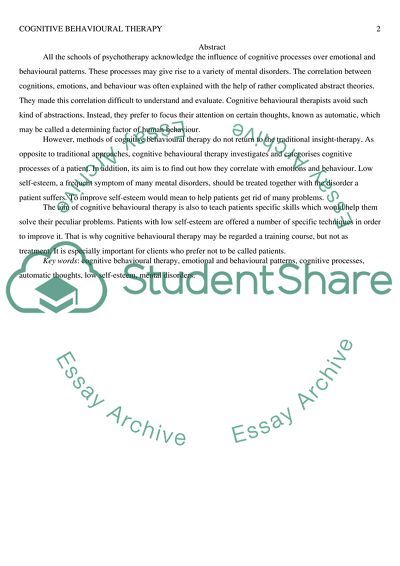Cite this document
(Cognitive-Behavioral Therapy in the Treatment of Low Self-Esteem Article Example | Topics and Well Written Essays - 2750 words, n.d.)
Cognitive-Behavioral Therapy in the Treatment of Low Self-Esteem Article Example | Topics and Well Written Essays - 2750 words. https://studentshare.org/health-sciences-medicine/1855958-demonstrate-a-critical-understanding-of-the-current-cbt-research-into-low-self-esteem-and-the-methods-utilised-to-research-this-area
Cognitive-Behavioral Therapy in the Treatment of Low Self-Esteem Article Example | Topics and Well Written Essays - 2750 words. https://studentshare.org/health-sciences-medicine/1855958-demonstrate-a-critical-understanding-of-the-current-cbt-research-into-low-self-esteem-and-the-methods-utilised-to-research-this-area
(Cognitive-Behavioral Therapy in the Treatment of Low Self-Esteem Article Example | Topics and Well Written Essays - 2750 Words)
Cognitive-Behavioral Therapy in the Treatment of Low Self-Esteem Article Example | Topics and Well Written Essays - 2750 Words. https://studentshare.org/health-sciences-medicine/1855958-demonstrate-a-critical-understanding-of-the-current-cbt-research-into-low-self-esteem-and-the-methods-utilised-to-research-this-area.
Cognitive-Behavioral Therapy in the Treatment of Low Self-Esteem Article Example | Topics and Well Written Essays - 2750 Words. https://studentshare.org/health-sciences-medicine/1855958-demonstrate-a-critical-understanding-of-the-current-cbt-research-into-low-self-esteem-and-the-methods-utilised-to-research-this-area.
“Cognitive-Behavioral Therapy in the Treatment of Low Self-Esteem Article Example | Topics and Well Written Essays - 2750 Words”. https://studentshare.org/health-sciences-medicine/1855958-demonstrate-a-critical-understanding-of-the-current-cbt-research-into-low-self-esteem-and-the-methods-utilised-to-research-this-area.


